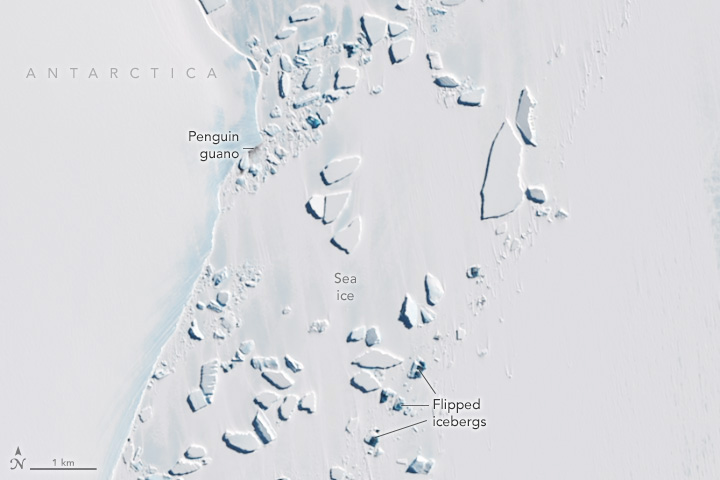Antarctic Icebergs Show Their Colorful Undersides (original) (raw)
Among a medley of snow-covered sea ice and icebergs off East Antarctica, some colorful features stand out from their surroundings. Jan Lieser, a meteorologist and sea ice scientist with the Antarctic Meteorological Service, spotted blue icebergs in satellite imagery near the Amery Ice Shelf in Prydz Bay.
The colorful icebergs can be seen in this image, acquired on October 26, 2024, with the OLI-2 (Operational Land Imager-2) on Landsat 9. These icebergs have been flipped over, showing the color of their snow-free undersides. Lieser has previously observed icebergs in this area that looked more jade in color.
In this part of the continent, the Lambert Glacier flows from the land and spreads out over the sea, forming part of the Amery Ice Shelf (located south of this image). Pieces occasionally break off from the front of the shelf and drift away as icebergs, many of which are visible amid an expanse of sea ice.
An iceberg’s glacial ice—made up of compressed snow and firn—contains air bubbles that scatter light and typically appears white like snow or bluish white. But in parts of the Amery Ice Shelf, seawater freezes to the underside of the shelf, hundreds of meters below the surface. The frozen seawater is free of bubbles and takes on the color of the water and its impurities.
“The clear marine ice can vary in color from deep blue, to green, to even brownish yellow, depending upon the concentration of constituents in the sea water,” said Collin Roesler, an oceanographer at Bowdoin College.
Roesler authored a study published in 2019 that found some icebergs near the Amery Ice Shelf take on a green color because of the presence of iron oxides in seawater acquired from rock dust on the mainland. The research suggested that such iron-laden bergs might be moving the mineral—an important nutrient for marine life—from the land to the sea.
“Our analysis suggested that the Amery Ice Shelf is particularly suited to forming green icebergs because of the conditions that support the accumulation of freezing seawater onto the underside of the shelf,” said Roesler. But the undersides of the bergs can only be seen if they overturn—a maneuver that can be triggered by the melting or breaking of an iceberg, which makes it unstable and more likely to flip. Roesler and colleagues previously surveyed the region by helicopter and found a high fraction of overturned bergs in this area.
In the same scene, Lieser also spotted a stain in the snow near the coast of Cape Darnley and said this was the accumulated guano from a sizeable emperor penguin colony. In previous research, scientists have discovered colonies in remote parts of Antarctica by searching satellite images for guano stains. Lieser added, “It’s interesting that we can see their excrement from space.”
NASA Earth Observatory image by Wanmei Liang, using Landsat data from the U.S. Geological Survey. Story by Emily Cassidy.
